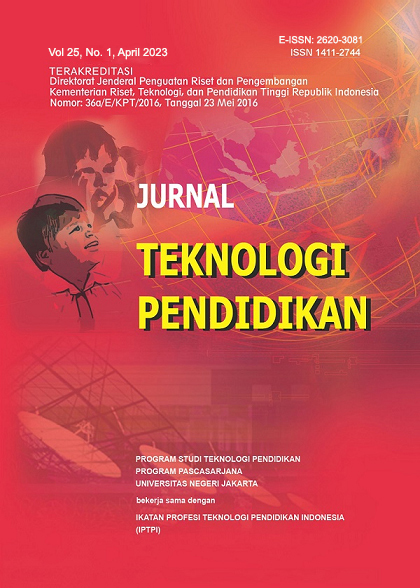Perception Of Early Grade Teachers Of Madrasah Ibtadaiyah Towards Attributes Innovations Of Thematic Learning
DOI:
https://doi.org/10.21009/jtp.v25i1.33290Keywords:
attributes innovations, perception of early grade teachers, thematic learningAbstract
Thematic learning is an integrated learning model that links or combines several subjects in one particular theme, in order to make it easier for students to see meaningful relationships, and make it easier for them to understand the material/concept as a whole. This study aims to analyze the perceptions of early grade MI teachers in Bireuen Regency towards thematic learning as an innovation based on its attributes (relative advantage, compatibility, complexity, trialability and observability). This study used a quantitative approach and diffusion research procedures developed by Rogers. The data in this study were collected by giving questionnaires to 29 MI early grade teachers in Bireuen District. The results showed that the thematic learning innovation attributes were relatively positively perceived by MI early grade teachers. Thus thematic learning is perceived to be more profitable (relative advantage) than previous learning models, a high level of compatibility with the values and norms adopted by the community, easy to implement (low level of complexity), trialability (can be tried out) and Early grade MI teachers perceive negatively the observability attribute.
References
Boeree, C George. (2013). General Psychologi: Psikologi Kepribadian, Persepsi, Kognisi, Emosi, & Perilaku. Yogyakarta: Prismasophie.
Ediana, Asep Latip. (2020) Difusi Inovasi Pembelajaran Tematik Di Madrasah Ibtidaiyah (A Diffusion Research of Innovation), Prosiding Seminar Nasional Pascasarjana Universitas Negeri Jakarta.
Feldman S, Robert. (2003). Essential of Understanding Psychology, New York: McGraw-Hill, Inc.
Fogarty, Robin. (1991). The mindful school: How to Integrated the Curricula. Pallatine, Illionis: IRI/Skylight Publishing, Inc.
Gagné, F. (2007). Ten Commandments for Academic Talent Development. The Gifted Child Quarterly, 51, 93–118. https://doi.org/10.1177/0016986206296660
Glenn S. Allan and W. C. Wolf Jr. (2009). Relationships between perceived attributes of innovations and their subsequent adoption, Peabody Journal of Education, https://doi.org/10.1080/01619567809538207
Gianluca Vagnani and Loredana Volpe. (2017). Innovation attributes and managers' decisions about the adoption of innovations in organizations: A meta-analytical review, International Journal of Innovation Studies, 1 107-133.
Hajar, Ibnu. (2013). Panduan Lengkap Kurikulum Tematik untuk SD/MI, Yogyakarta, Diva Press.
Jayson. (2011). Challenges of Adopting the Use of Technology in Less Developed Countries: The Case of Cambodia. Comparative and International Education Society. The University of Chicago Press Journals, 55(1).
Lastriningsih, L. (2017). Peningkatan berpikir kritis dan prestasi belajar melalui metode inquiry pada siswa kelas IV SD. Jurnal Prima Edukasia, 5(1), 68-78. https://doi.org/10.21831/jpe.v5i1.7714
Leal, Edvalda Araujo and Alberto Luiz Albertin. (2015). Determinants of the Use Technological Innovation in Distance Learning: A Study with Business School Instructur, Turkish Online Journal of Distance Education, 16(1), 19-37
Paimun, P., & Masruri, M. (2014). PENGEMBANGAN SUBJECT SPESIFIC PEDAGOGY TEMATIK UNTUK MENINGKATKAN KEJUJURAN DAN KEDISIPLINAN SISWA KELAS I SD. Jurnal Prima Edukasia, 2(2), 194-208. https://doi.org/10.21831/jpe.v2i2.2719
Risminawati, R., & Fadhila, N. (2016). PERSEPSI GURU TERHADAP IMPLEMENTASI PEMBELAJARAN TEMATIK INTEGRATIF KURIKULUM 2013 DI SEKOLAH DASAR MUHAMMADIYAH. Profesi Pendidikan Dasar, 3(1), 58-65. https://doi.org/10.23917/ppd.v3i1.2604
Robbins, Stephen P. (2007). Perilaku Organisasi Buku 1. Jakarta: Salemba Empat, p. 174-184.
Rogers, Everett M. (2003). Diffusion Of Innovations Fifth Edition. New York: The Free Press
Tanye, Hannah Ayaba. (2016). Perceived Attributes of Innovation: Perceived Security as an Additional Attribute to Roger‟s Diffusion of Innovation Theory. International Journal of Multicultural and Multireligious Understanding, 3(1), 6-18. http://dx.doi.org/10.18415/ijmmu.v3i6.57
Downloads
Published
How to Cite
Issue
Section
License
Jurnal Teknologi Pendidikan is an Open Access Journal. The authors who publish the manuscript in Jurnal Teknologi Pendidikan agree to the following terms.
Attribution-ShareAlike 4.0 International (CC BY-SA 4.0)
-
Attribution — You must give appropriate credit, provide a link to the license, and indicate if changes were made. You may do so in any reasonable manner, but not in any way that suggests the licensor endorses you or your use.
-
ShareAlike — If you remix, transform, or build upon the material, you must distribute your contributions under the same license as the original.
- No additional restrictions — You may not apply legal terms or technological measures that legally restrict others from doing anything the license permits.
Notices:
- You do not have to comply with the license for elements of the material in the public domain or where your use is permitted by an applicable exception or limitation.
- No warranties are given. The license may not give you all of the permissions necessary for your intended use. For example, other rights such as publicity, privacy, or moral rights may limit how you use the material.








